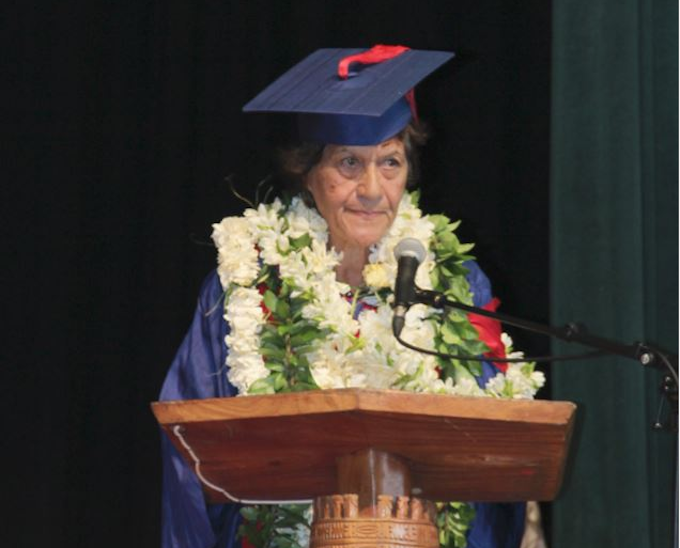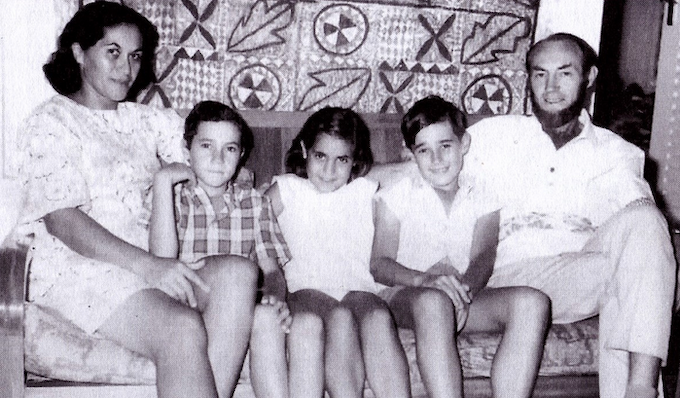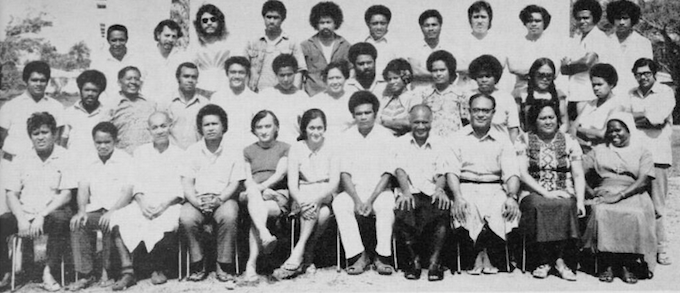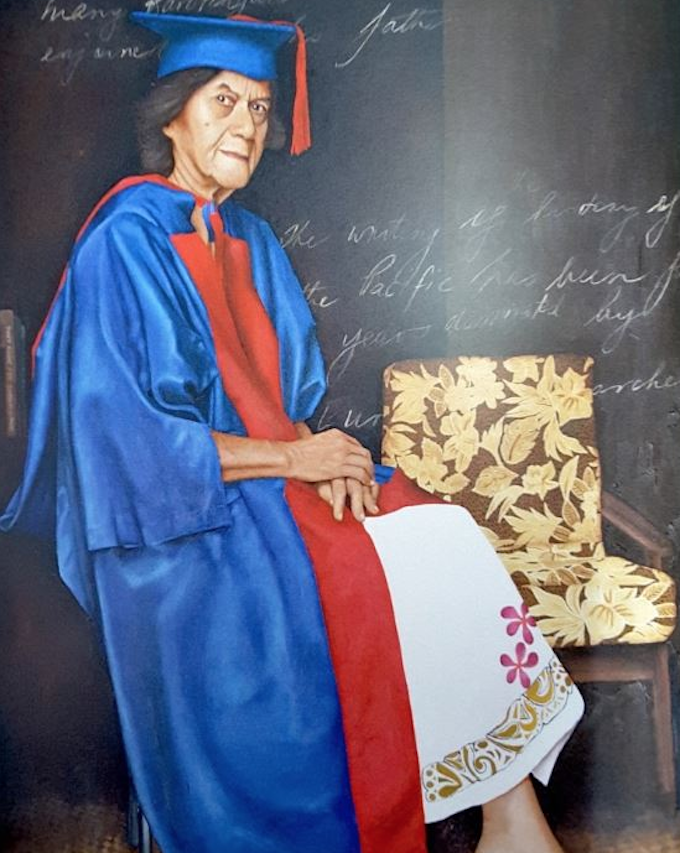
By Rod Dixon in the Cook Islands News
Marjorie and Ron Crocombe lived up to exacting standards in their personal and professional lives and their combined efforts impacted and inspired uncountable others. We were privileged to know them.
Marjorie Tua’inekore Crocombe (née Hosking) was born in 1930 in Rarotonga, the youngest of 11 children of Dr Rupert and Vaevae Hosking of Titikaveka.
Marjorie was educated at Titikaveka Primary School (1936-44) and in 1944 won a Maui Pomare scholarship to finish her secondary schooling in New Zealand, initially at Epsom Girls Grammar School (1945-6) and later at Whanganui Girls College where she became the first Polynesian head prefect (1947-50).
It wasn’t until many years later that she realised that her time at the school had been instrumental in allowing more New Zealand Māori girls to complete their secondary schooling at Whanganui Girls’.
In an interview with Katrina Lintonbon (Cook Islands News, 13 June, 2020), Marjorie recalled that: “When she thinks about it now, there were only three students that weren’t European when she was at the college. She used to wonder why “Miss Baker” would come to see her every night to see how her studies were going.
“All those years later I finally realised what she was doing, she had been fighting with the school’s board of governors to allow Māori girls to attend the school,” she says.
“There was so much racism back then.”
Trained as teacher
In 1951, Marjorie trained as a teacher at Ardmore Teachers Training College, graduating in 1952. After a year’s teaching at Henderson Primary School, Auckland (1953-4), she returned to Rarotonga to begin work for the Cook Islands Department of Education, and in 1955 became the first Cook Islands female lecturer at Nikao Teachers College.
During this time, she also worked on developing primary school readers in the Cook Islands Māori language.
At a dance in 1955 she met her future partner, Ron Crocombe. Ron had come to Rarotonga initially as Clerk of Works in the Public Works Department and was then appointed as Resident Agent on Atiu.
As Marjorie recalled to journalist Katrina Lintonbon, Ron was on his way back to New Zealand from Atiu and asked if she would join him.
“I said to him, ‘No way! For a start I don’t even know you.’”
“He replied, ‘We can get to know one another on our way back to New Zealand.’”
They were married in 1959 in Masterton, NZ, and a 50-year partnership began.
That same year, Marjorie accompanied Ron to Canberra where he had been offered a PhD scholarship in Pacific history. She was initially barred from entering Australia under the racist “White Australia” policy, but finally, under protest, was allowed entry.
Ethnohistory works
While Ron worked on his thesis, Marjorie commenced work on The Works of Ta’unga; Records of a Polynesian Traveller in the Southern Seas, 1833–1896 (ANU Press, 1968). This work (co-edited with Ron) “combined the two strands of ethnohistory and an Islands-focused historiography” to become one of the foundational texts of Pacific history (Lal and Munro, 2006).

In 1962, Ron and Marjorie and their family moved to live and work in Papua New Guinea following Ron’s appointment as executive officer, and from 1965, director of ANU’s New Guinea Research Unit. In Port Moresby, Marjorie became a lecturer at the Teachers College and the Administrative College, as well as conducting a regular ABC radio broadcast “Malanga Moana” covering Pacific music and current affairs (1966-9).
In 1965 during sabbatical, she undertook a part-time anthropology degree at the University of California (Los Angeles) and in 1968, studies in Pacific history at the University of Hawai’i.
In 1967, she began a degree at the University of Papua New Guinea (UPNG), studying creative writing under Ulli and Georgina Beier and publishing her research into the work of the influential Mangaian missionaries to Papua, Ruatoka and his wife Tungane. All this was achieved in addition to bringing up two children without added help, for Ron and Marjorie refused on principle to employ domestic servants.
In Port Moresby, Marjorie was again forced to confront racial discrimination as Ron later recalled.
“The first time she went to buy meat at the main Burns Philp shop in Port Moresby she was refused service. She came home in tears after being told that natives can only be served through the outside hatch. She had been in many countries but never treated like that. She never went back, but it was a small part of the accepted code of the Australian system in Papua New Guinea.”
In 1969 the family moved to Suva, following Ron’s appointment as foundation professor of Pacific studies at the newly established University of the South Pacific. At USP, Marjorie completed her Arts degree majoring in history and education. Influenced by her creative writing teachers at UPNG, she helped establish and became first president of the South Pacific Creative Arts Society (SPACS), a post she retained for 23 years (1977-2000).
Battling established thinking
Once again she was required to battle established thinking, this time within a university that, at the time, placed greater emphasis on economic and social development than on the creative arts.
SPACS provided a platform for a “New wave of Pacific writers” through its journal Mana with Marjorie as editor. Many of the early writers published in Mana, including Albert Wendt, Konai Thaman, the late Alistair Te Ariki Campbell and the late Grace Molisa, were or became internationally famous writers and scholars, leading the Cook Islands academic Emily Powell to wonder, would there have been a Pacific literature at all if Marjorie and her colleagues had not established SPACS and sustained Mana with their own tireless work?
“Writers and publishers from the wider region,” writes Dr Linda Crowl, “owe a deep debt to Marjorie’s foresight and generosity.”

In 1974, Marjorie completed her Master of Arts degree at UPNG with a dissertation entitled – “Maretu’s Narrative of Cook Islands History” – later published as Cannibals and Converts: Radical Change in the Cook Islands (USP Press, 1983).
At USP, both Ron and Marjorie were indefatigable advocates of a decentralised university with Ron writing and teaching the first ever degree level correspondence course offered by USP Extension, An Introduction to Pacific Land Tenure in 1974.
At the same time, Marjorie worked as director of the Fiji Extension Centre, then at the Solomon Islands Extension Service, and finally as director of USP Extension Studies (1983-88), with responsibility for delivering extension studies to the university’s 12 member countries.
In September 1987, Marjorie was sitting in her office at USP’s Laucala campus when soldiers arrived with orders to “off the (satellite) machines” as Fiji’s September coup was under-way.
Uncowed by threats
Uncowed by threats of violence, Marjorie spent a brief afternoon in detention, guarded by a young and apparently respectful armed soldier, musing how she might overpower him and “pin him to the ground in one helpless pile of jungle greens”.
For their 20 plus years in Suva, Ron and Marjorie’s home at 6 Mariko Street, was a refuge for Pacific students — in John Herrmann’s words — “a marae, in essence ‘a home away from home’ for many students and staff members from across the region … (providing) a homely outing, a quiet exchange, some informal counselling, and above all else, some island songs from home”.
Following her retirement from USP in 1988, Marjorie was appointed senior lecturer and foundation director at the Centre for Pacific Studies at the University of Auckland (1990-1993).
Returning to the Cook Islands she was appointed deputy chair of the Cook Islands Media Council, a member of the Biodiversity Committee, and of the Education Sector Review, the Higher Appointments Committee, the Cultural and Historic Places Trust, and the Cook Islands Research Association while also supporting innumerable NGOs and lecturing at USP Cook Islands.

Following Ron’s death in 2009, she co-edited (with Rod Dixon and Linda Crowl) a book on his life and work, entitled Ron Crocombe: E Toa: Pacific Writings to Celebrate His Life and Work.
Despite advancing age, Marjorie continued to champion poetry and literature, and, as Rachel Reeves noted, remained “outspoken about encouraging Pacific writers to analyse contemporary life through poetry, art and stories”.
This bore added fruit in 2003 with the publication of the 400-page Akono’anga Māori – Cook Islands Culture featuring 25 local authors writing on aspects of Cook Islands culture, economy and society, followed in 2016 by Art and Architecture of the Cook Islands (co-edited again with Rod Dixon and Linda Crowl).
Woman of the Year
Among her honours, Marjorie was named by Islands Business their 1990 Pacific Islands Woman of the Year, and in 2000 the Cook Islands Business and Professional Women’s Association as their Woman of the Year. In the 2009 New Year Honours List, Marjorie was appointed Officer of the Order of the British Empire (OBE) for services to the Cook Islands, the Pacific, education, literature and the community
In 2011, her alma mater honoured her with the award of a Doctor of Letters (honoris causa) in recognition of “her exceptional academic, literary and community achievements”. The citation included 6 full pages recording all of Marjorie’s published works covering subject areas including Pacific History, Pacific Literature, Education, Current Affairs, Information Technology, and Pacific Women as well as 22 edited publications.
The following year, USP Cook Islands campus commissioned a full-length portrait from the Pacific artist Nanette Lela’ulu. The artist pictured Marjorie in doctoral robes with bare feet on a woven mat emphasising her “groundedness” in the Pacific.
Ron’s empty chair standing beside her in the portrait depicted the now absent “other half” of a 50-year partnership.
On the university’s 50th Anniversary in 2018, USP Cook Islands celebrated Marjorie’s pivotal role in the development of Pacific Literature with publication of the book Mana – 50 Years of Cook Islands Writing, a tribute to Marjorie Crocombe.
In the same year, Marjorie fulfilled another goal by successfully lobbying the university to develop a full degree programme in her much-loved Cook Islands Māori language. Attending the opening of the Confucius Classroom at USP Cook Islands, Marjorie took the opportunity to question the vice-chancellor as to why the university taught Chinese but not Pacific languages.
As the university approached its 50th Anniversary, she argued, that the teaching of Pacific vernacular language programmes would help affirm the university’s commitment to regionalism. The then Cook Islands Prime Minister Henry Puna had been recently installed in the largely ceremonial, yet influential, role of chancellor of the university and Marjorie was quick to lobby him for a degree in Cook Islands Māori.
Pacific language degrees
The degree was introduced in 2018 and once established, was followed by Tongan and Niuafo’ou, Vagahau Niue, and Rotuman. The first students with a Diploma in Cook Islands Māori graduated in 2021.
Anyone who has borrowed books from the Crocombe’s extensive library will have noticed an ex-libris plate on the inside front cover of each book containing the words of the French-American Quaker missionary Stephen Grellet, which reads: “I shall pass through this world but once. Any good therefore that I can do, or any kindness that I can show, to any human being, let me do it now. Let me not defer or neglect it for I shall not pass this way again.”
In living a fulfilling life, not deferring nor neglecting but actively seizing opportunities to do good, helping innumerable lives along the way, Marjorie and Ron lived up to their exacting life motto.
Their combined efforts have impacted and inspired uncountable others. We were privileged to know them.
Marjorie is survived by by four children, 14 grandchildren and eight great-grandchildren.
Rod Dixon is a former University of the South Pacific centre director. This article was first published in the Cook islands News and is republished with permission.
References
Gray, Geoffrey and Doug Munro (2018). “Ron & Marjorie Crocombe and Harry Maude: Partnerships, Ethnohistory and Publishing”, in Bérose – Encyclopédie internationale des histoires de l’anthropologie, Paris.
Lintonbon, Katrina (2020, June 13). Pages from the book of Marjorie Crocombe’s life, Cook Islands News.
Reeves, Rachel (2016, June 6). Marjorie Crocombe honoured and described as a beacon of light, Cook Islands News.








































